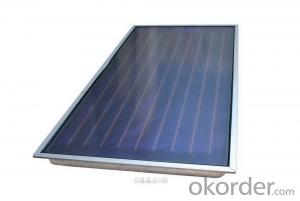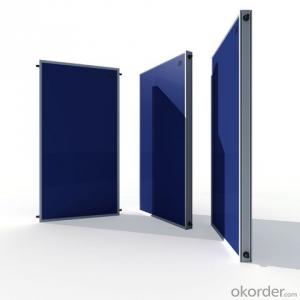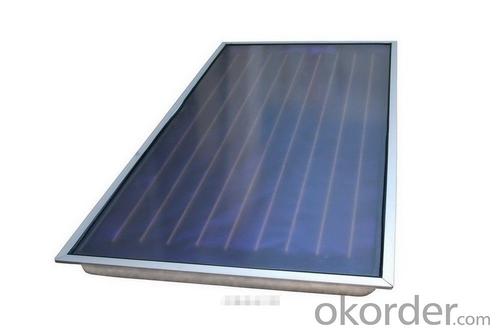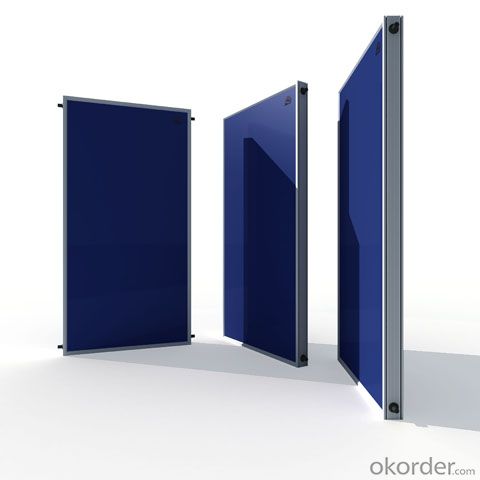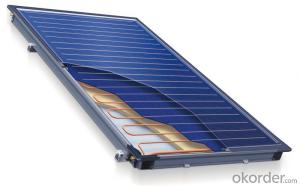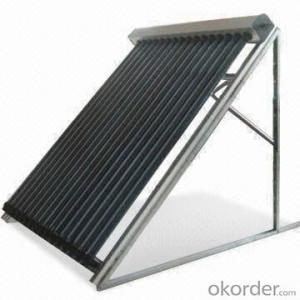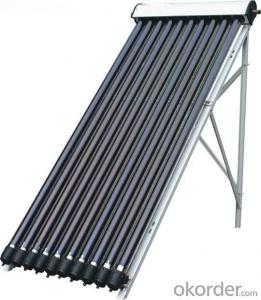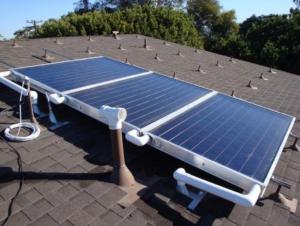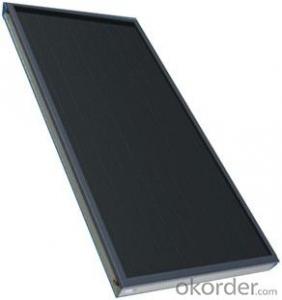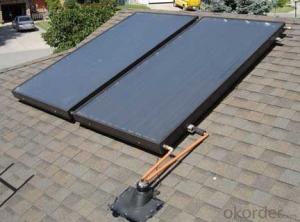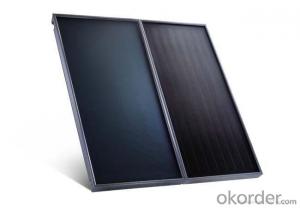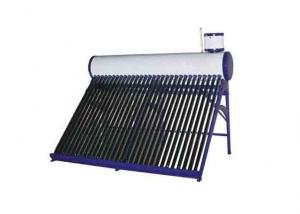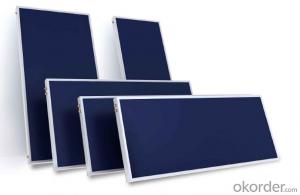Black Chrome Flat Panel Pool Solar Collectors
- Loading Port:
- Shanghai
- Payment Terms:
- TT OR LC
- Min Order Qty:
- 500 pc
- Supply Capability:
- 10000 pc/month
OKorder Service Pledge
OKorder Financial Service
You Might Also Like
Specifications
Flat panel solar thermal collector
Low iron tempered glass
Core: all Copper, ultrasonic welding.
Coating: black chrome
Flat panel solar thermal collector
consist of glazed, flat, dark surfaced absorber plate which contains copper tubing. The Plate absorbs incoming solar heat energy and the casing minimises heat loss. A fluid is circulated through the tubing and this fluid heats up as it passes by the absorber plate.
Feature:
1) Absorptance: ≥95%±2%.
2) Material:thickness:low iron rohbic tempered glass x thickness: 3.2mm.
3) Glass sheet size: 1988×988 mm.
4) Glass transmittance: 87%~91%.
6) Insulation material:Rock wool.
7) Back sheet material: Zincification plate0.3mm; embosseo Aluminum0.5mm.
8) Cross area: 2 m2.
9) Heat absorber area: 1.8 m2.
10) Fluid content: 2L.
11) Maximumpressure: 1 Mpa.
12) Operation temperature: -40~150°C.
Flat Plate Collectors
Flat plate collectors are the most common solar thermal collectors. They are most appropriate for low temperature applications, such as domestic hot water heating. Flat plate series water heaters maximizes solar heat gain, minimizes heat losses, and provides for the most efficient heat transfer from absorber plate to tube.
Flat Plate Solar Collectors are a glazed collectors which
feature a coating which maximizes heat absorption, aluminum framing which can withstand heavy weight and is weather resistant, and interior fiberglass insulation which allows for greater efficiency. The combination the latest energy efficiency technology and a strong heat exposure allow for optimal heat transfer and makes these lights the highest in BTU performance.
An important asset of flat plate solar collectors is their versatility. Their excellent efficiency makes them also suitable for the operation of larger systems for commercial or public use. Solar Flat Plate collectors are typically recommend for use in warmer climates simply because they are designed with larger absorber areas that are not insulated from the colder weather.
- Q: Can solar collectors be used for heating nursing homes?
- Yes, solar collectors can be used for heating nursing homes. Solar thermal systems can provide hot water and space heating for nursing homes by harnessing the sun's energy and converting it into heat. This can help reduce energy costs and lower carbon emissions while providing a sustainable heating solution for these facilities.
- Q: Can solar collectors be used for heating car manufacturing plants?
- Yes, solar collectors can be used for heating car manufacturing plants. By harnessing the power of the sun, solar collectors can generate heat energy which can be utilized to warm up car manufacturing plants. This can help reduce reliance on traditional heating methods, lower energy costs, and decrease carbon emissions associated with heating.
- Q: Can solar collectors be used for heating beverage production facilities?
- Yes, solar collectors can be used for heating beverage production facilities. Solar thermal systems, such as flat plate or evacuated tube collectors, can capture the sun's energy and convert it into heat, which can then be used for water heating or space heating in the facility. This can help reduce the reliance on traditional heating methods and decrease energy costs while promoting sustainability.
- Q: Can solar collectors be used for heating swimming pools in summer?
- Certainly, solar collectors are capable of heating swimming pools during the summer months. These devices, also referred to as solar panels or solar thermal systems, absorb sunlight and convert it into heat energy. This heat energy can then be transferred to the pool water, effectively raising its temperature. During the summer season, when the sun is at its strongest and the weather generally warmer, solar collectors are especially efficient at harnessing solar energy. The panels utilize solar radiation to warm a fluid, typically water or an antifreeze solution, which is then circulated through a heat exchanger to heat the pool water. Solar collectors represent an eco-friendly and cost-effective solution for pool heating. They make use of renewable energy from the sun, which is freely available, reducing dependence on conventional energy sources like electricity or gas. This can result in substantial long-term savings on energy costs. Furthermore, the use of solar collectors for pool heating can extend the swimming season, enabling pool owners to enjoy their pools for a longer duration. It also eliminates the need for alternative heating methods, such as electric or gas heaters, which can be more costly to operate. However, it is essential to acknowledge that the effectiveness of solar collectors for pool heating depends on various factors, such as the size of the collector system, the placement and orientation of the panels, and the size and insulation of the swimming pool. Proper design and installation are vital to ensure optimum performance and heat transfer. In conclusion, solar collectors can effectively heat swimming pools during the summer season. They provide a sustainable and cost-efficient solution, allowing pool owners to relish warm pool water while minimizing their environmental impact and energy expenses.
- Q: How do solar collectors affect property value?
- The installation of solar collectors on a property can greatly impact its value in a positive manner. By incorporating solar collectors into a property, potential buyers are more likely to be drawn to it due to the homeowner's dedication to sustainability and renewable energy. Furthermore, solar collectors serve as a reliable source of clean and renewable energy, ultimately leading to decreased energy expenses for the homeowner. This financial advantage is also attractive to potential buyers as it guarantees long-term savings on utility bills. Additionally, solar collectors may qualify for various government incentives and tax credits, thereby amplifying the property's value even more. Consequently, the inclusion of solar collectors on a property significantly enhances its desirability and marketability, subsequently raising its overall value.
- Q: Can solar collectors be used for heating recreational vehicles and boats?
- Yes, solar collectors can be used for heating recreational vehicles and boats. Solar heating systems, such as solar water heaters or air heaters, can be installed on these vehicles to harness the sun's energy and provide heating for the interior spaces or water systems. These systems are environmentally friendly and can help reduce the reliance on traditional fuel sources while providing an efficient heating solution for recreational vehicles and boats.
- Q: Are solar collectors suitable for agricultural processing facilities?
- Indeed, agricultural processing facilities can benefit from the use of solar collectors. These collectors, which can come in the form of solar panels or solar thermal systems, present a sustainable and cost-effective energy option for these facilities. In order to carry out activities such as crop drying, water heating, and machinery operation, agricultural processing facilities often consume a significant amount of energy. However, by harnessing the power of solar collectors, these facilities can decrease their reliance on traditional energy sources, decrease operational expenses, and contribute to an environmentally-friendly and more sustainable agricultural sector. When it comes to generating electricity, solar collectors, specifically photovoltaic (PV) panels, can be utilized. This electricity can then be utilized to power a variety of agricultural processing equipment and machinery, reducing the necessity for grid electricity or generators. What's more, surplus electricity generated by the solar panels can be stored in batteries or even fed back into the grid, thus providing an additional source of income for the facility. On the other hand, solar thermal systems are capable of harnessing the sun's heat for various applications within agricultural processing. This heat can be used for crop drying, water heating for cleaning or sterilization purposes, and even space heating during colder periods. Solar thermal systems can be seamlessly integrated into pre-existing systems, such as boilers or water heaters, in order to supplement or replace traditional energy sources such as fossil fuels. Furthermore, solar collectors offer numerous benefits beyond energy savings. They require minimal maintenance and boast an extended lifespan, thus making them a reliable and durable choice for agricultural processing facilities. Additionally, the utilization of solar energy aids in the reduction of greenhouse gas emissions, thereby contributing to a cleaner and healthier environment. All in all, solar collectors are an efficient and fitting solution for agricultural processing facilities, as they provide a sustainable and dependable energy source, decrease operational expenses, and support efforts towards environmental conservation.
- Q: Can solar collectors be used for generating electricity on hospitals?
- Yes, solar collectors can indeed be used for generating electricity on hospitals. Solar collectors, also known as solar panels or photovoltaic (PV) panels, are devices that convert sunlight into electricity. They can be installed on the roof or any open space of a hospital building to harness solar energy and generate electricity. Using solar collectors for electricity generation on hospitals has several benefits. Firstly, it reduces reliance on traditional sources of electricity, such as fossil fuels, which are not only expensive but also contribute to air pollution and climate change. By utilizing solar energy, hospitals can significantly lower their carbon footprint and contribute to a cleaner and more sustainable environment. Secondly, solar collectors provide a reliable and consistent source of electricity. Hospitals require a constant and uninterrupted power supply to operate essential medical equipment, lighting, HVAC systems, and other critical services. Solar panels can generate electricity even during cloudy days, ensuring a reliable power source for hospitals. Moreover, installing solar collectors on hospitals can also help in reducing energy costs. While the initial investment of installing solar panels may be higher, they have a long lifespan and require minimal maintenance. Over time, hospitals can save a significant amount of money on their electricity bills, allowing them to allocate more resources to patient care and other essential services. In addition to generating electricity, solar collectors can also be used for heating water in hospitals. Solar thermal collectors can capture the sun's heat and transfer it to water, providing hot water for various hospital needs such as bathing, cleaning, and sterilization. Overall, solar collectors are a practical and sustainable solution for generating electricity on hospitals. They not only reduce dependence on fossil fuels and contribute to environmental conservation but also offer long-term cost savings and a reliable power source for essential hospital operations.
- Q: Can solar collectors be used for heating museums?
- Yes, solar collectors can be used for heating museums. Solar thermal collectors can be installed on the rooftops or nearby areas of museums to harness the sun's energy and convert it into heat. This heat can then be used to warm up the museum's interior spaces, providing a sustainable and environmentally friendly heating solution. Additionally, solar collectors can also be used to heat water which can be utilized for various purposes within the museum, such as floor heating or for maintaining ideal humidity levels.
- Q: Can solar collectors be used for agricultural purposes?
- Yes, solar collectors can be used for agricultural purposes. They can be used to power irrigation systems, provide heat for greenhouses, and generate electricity for farm operations. Solar collectors can help reduce the reliance on fossil fuels, lower energy costs, and contribute to sustainable farming practices.
Send your message to us
Black Chrome Flat Panel Pool Solar Collectors
- Loading Port:
- Shanghai
- Payment Terms:
- TT OR LC
- Min Order Qty:
- 500 pc
- Supply Capability:
- 10000 pc/month
OKorder Service Pledge
OKorder Financial Service
Similar products
Hot products
Hot Searches
Related keywords
